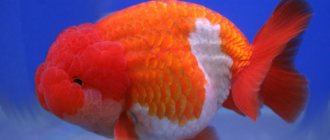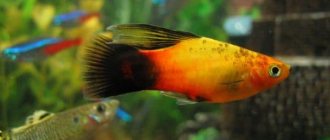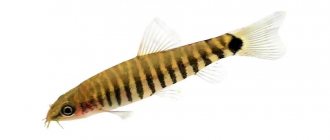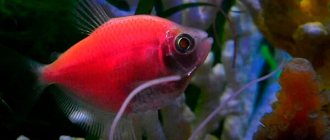Shubunkin (lat. Carassius gibelio forma auratus) is one of the most beautiful goldfish in color, since its color consists of spots of different colors, randomly scattered throughout the body. This coloring is quite rare in other gold ones; they are more uniform in color and evenly colored. These gorgeous fish are some of the hardiest goldfish varieties. They are very easy to keep, as they are unpretentious in feeding and conditions. Active, mobile, they are well suited for keeping in a community aquarium.
Behavior and Compatibility
These are hardy fish that are easy to care for. They can be quite large and require sufficient space for maintenance. Therefore, it is better to keep them in ponds that imitate their natural environment and have enough space for full development. They prefer to stay in groups.
These peaceful freshwater fish are not picky about water parameters and remain healthy with minimal care. Can be kept with many other fish species with similar conditions, except the more aggressive ones.
Can Shubunkin live with other types of goldfish? If we talk only about behavior, then yes. However, you must be sure that the species you choose will not be slow and timid, because such fish will have food taken right from under their noses.
If you find that the Shubunkins are still dominating the tank and taking food from other fish, you can feed them on one side of the tank first and then feed the slower fish on the other. You can avoid this discrepancy by adding other goldfish to the aquarium. Comet, koi and common goldfish can more than match the Shubunkin's activity.
In addition to the aforementioned aquarium neighbors, the Shubunkin can get along well with crustaceans and peaceful catfish (loricaria, corydoras, etc.). Incompatible with aggressive fish such as cichlids. The invertebrates you add to such a community must not be small so as not to end up as food.
Shubunkin's homeland
The fish was bred by Japanese breeders in 1892. Shubunkin is the fruit of crossing a single-tailed wakin, a regular goldfish and a calico telescope. The species received its official name in 1900. Beautiful fish live successfully both in home aquariums and in decorative, artificial ponds.
The variety was introduced to European countries at the beginning of the last century. Very soon, the Shubunkin, resembling a colorful comet, ended up among Russian aquarists. The main ancestor of all goldfish subtypes is Carassius gibelio (goldfish).
In Japanese pronunciation, the name of the species sounds like “shubunkin” (translated as “red brocade”). This species is the pride of Japan.
In the standard version, the color scheme of Shubunkins includes red, black, yellow, whitish and bluish spots with an overall snow-white body color. But there are also rare individuals with a soft blue color, which are the most valuable. Blue spots on the body appear at 2-3 years of fish life.
Aquarium
The recommended minimum aquarium size is 50 liters per fish. This means that you will need a lot of space. This again confirms that it is better to keep them in a pond. In addition, these fish grow quickly, so you need to choose a larger aquarium from the very beginning.
Larger fish will require more space, so it is recommended to use a pond instead of an aquarium. If you don't have enough indoor space or plan to keep only 1 or 2 specimens, a pond is the best option. It can ensure that your fish have enough space and natural conditions that mimic what is in their genes. The water flow should be slow and constant.
Plants that can be placed in an aquarium must have a developed root system. As for the soil itself, it is better to use larger pebbles rather than sand or fine gravel, as they mistake it for food. A larger substrate will give them the opportunity to collect leftover food, as in the natural environment.
You should choose a good filtration system or you will need to clean the tank quite often as these fish are very active and produce a lot of waste.
Water parameters:
Temperature: 18 - 23° C pH: neutral, 6.0 - 8.0 Hardness: 5-19° dGH
They do not require special care other than regular maintenance. To keep your fish healthy, just make sure they always have clean water. The water can become contaminated by leaves and the like if the pond is outdoors, and their tendency to make a mess in the tank can also ruin the water quality.
To prevent possible diseases, plan to change the water about 25% once a week.
Monitor your fish closely to make sure they are healthy. If signs of illness appear, it is important to isolate the sick fish from the group until they recover to prevent spread.
How to breed Shubunkins
Breeding these fish is not particularly difficult. The only difficulty is determining the sex of individuals. It is possible to distinguish a female from a male only on the eve of spawning, by her rounded belly. During this period, the male develops whitish tubercles near the gill slits and on the head. Further actions for fish breeding will be as follows:
- Preparing the spawning area. An aquarium with a capacity of 50 liters or more is suitable for these purposes. The bottom of the spawning tank is laid out with a net; additionally, aquatic plants can be placed. Organize medium aeration and filtration.
- Future parents (a female and 2-3 males) are placed in a spawning tank and provided with enhanced nutrition with a high protein content.
- Spawning is stimulated by a decrease in temperature to +11-15⁰С, and then a gradual increase by 1.5-2⁰С per day.
- During the spawning period, males actively swim after the female and “knock out” eggs from her, which are immediately fertilized. At one time, the female can bring up to 2-3000 eggs.
- After the process is completed, the parents are returned to the common aquarium (Shubunkins do not have a developed parental instinct, and they can eat their own offspring).
- After 5-6 days the fry appear. At first they feed on the yolk membrane. As soon as the young animals begin to swim, live dust (ciliates) is introduced into the diet, then Artemia nauplii.
Nutrition
When we say they love to eat, it's an understatement. When compared to other goldfish species or their ancestors, one might conclude that they ate whatever they could find.
Thanks to the omnivorous nature of these fish, you can give them almost anything. Pellets and flakes are a great food to start with, but since they are omnivores, supplement their diet occasionally with delicacies.
Consider additional natural feeding, plant-based and frozen foods; they will definitely appreciate the occasional addition of bloodworms, gammarus, etc. to their diet.
To keep feeding under control, feed them only as much food as they can eat in 2-4 minutes.
Breeding
It is quite possible to breed Shubunkins at home. The spawning area should be about 100 liters, and the breeding season usually occurs in the spring. To stimulate spawning, the water in the spawning area is softened and the temperature is increased by 3-5°C. The water should remain fresh and illuminated from early morning. Clean sand is placed at the bottom of the spawning area, and bushes of small-leaved plants are placed in the corners.
The fry are fed rotifers and brine shrimp. It is advisable to separate the juveniles depending on their size.
Return to content
Notes
Shubunkins are great for aquariums because they are easy to care for and hardy. Both new and experienced aquarists can be captivated by their unique colors and relatively affordable price.
If you are looking for a colorful addition to your aquarium, the Shubunkin is a great choice. Available at most pet stores, they will keep you company for years to come and live up to their calico name with many color variations, including shades of blue!
Description
The fish has an elongated, laterally compressed body. This makes it very different from other goldfish, such as the telescope, whose body is short, wide and round. The fins are long, always erect, and the caudal fin is forked.
Shubunkin is one of the smallest goldfish. It all depends on the size of the reservoir in which it is contained.
For example, in a cramped 50-liter aquarium, the Shubunkin grows up to 10 cm. In a larger volume and in the absence of overpopulation, it will grow to about 15 cm, although some data report 33 cm fish.
This can also happen, but in ponds and with very abundant feeding.
The average life expectancy is 12-15 years, although longer periods are not uncommon.
The main beauty of the Shubunkin is in its coloring. It is very diverse, and according to rough estimates, there are more than 125 different options.
But they all have one thing in common - red, yellow, black, blue spots randomly scattered throughout the body. For such diversity, the fish even received the name calico.
Feeding
- Shubunkin is distinguished by a voracious appetite, however, like all representatives of goldfish. Keep in mind that if you overfeed individuals, they may soon die from obesity. The fact is that these fish eat absolutely everything you offer them.
- Individuals are omnivorous representatives of goldfish. They will eat live, frozen or artificial food without any problems. As a permanent basis, the fish can be given granules or high-quality flakes. At the same time, do not forget that artificial feed should be given in smaller quantities.
- Otherwise, the fish begin to develop problems with the digestive system in the form of constipation. Therefore, you should not limit individuals to only this food. Be sure to regularly feed them brine shrimp, bloodworms, tubifex and earthworms. In addition, pets will also need plant foods.
- They eat finely chopped cabbage and lettuce leaves very well. Keep in mind that such food must be doused with boiling water in advance. After feeding, leftover food must be removed. Otherwise, the aquarium will often get dirty. If possible, feed your fish several times a day in small portions.
Sex differences
Male and female Shubunkin are very difficult to distinguish from each other. Male and female fish have the same appearance. Sexual differences become noticeable only during spawning. During this period, the male develops raised white spots on his head and gills. The female's body becomes rounded due to the gestation of eggs. Outside of spawning, it is almost impossible to determine the sex of the Shubunkin.
Let's consider the features of keeping shubunkins. Fish of this breed are quite unpretentious, but space is very important for them. Crowding has a negative impact on their growth and development. In order for calicos to feel comfortable, the following conditions must be created for them:
Space in the aquarium. Shubunkins are quite mobile, so they need a lot of space. The volume of the aquarium for keeping them must be at least 100 liters. When choosing it, you should give preference to rectangular-shaped tanks. In round aquariums, fish see poorly and grow worse. Good filtration and aeration of water. You should purchase a powerful filter from an aquarium store. Shubunkins love to dig in the ground and often create a lot of turbidity in the water. You also need to take care of purchasing a high-quality aerator. Calicos are unpretentious and very hardy, but they do not tolerate a lack of oxygen well. Lack of heat and clean water. Shubunkins are considered cold-loving fish. They do not do well in overly warm conditions. The optimal temperature in the aquarium for fish should be from +20 to +23 degrees. Calicos are not very sensitive to the purity of the liquid. However, it is recommended to change the water in the tank by 1/5 weekly. Safety of the soil and design elements. Calicos can swallow small pebbles. These grains get stuck in their stomach and lead to the death of the fish. To eliminate this danger, only coarse gravel or sand can be used as soil. Do not place sharp driftwood in the aquarium, as this may cause injury to the fins. A large number of strong plants. The Shubunkin fish loves to live near the ground and dig up the roots of algae. At the same time, calicos feel comfortable in a well-landscaped aquarium. Therefore, you need to plant a large number of aquatic plants with strong leaves and roots. Daylight. Shubunkins love natural sunlight, so it is best to place the aquarium on the windowsill
It is very important to ensure that the water does not overheat, as heat is detrimental to calicos. Natural light can be replaced with artificial light, but the lamp must be bright enough and burn for about 8 - 12 hours a day.
Goldfish "Pearl"
This fish is very easy to recognize by its round belly and unique scales. It consists of rows of small, tough scales that resemble beads and cover most of its body. The characteristic “pearls” are actually composed of calcium carbonate deposits. However, on very large adult fish they can become quite large.
The Pearl goldfish is very easy to recognize by its round belly and unique scales. © mSafdel
Necklaces on the scales give the fish a fantastic look and attract everyone's attention to the representatives of the breed. The "beads" on the scales develop with age and may be absent in young specimens.
Pearl fish come in many colors, including calico (the most common), orange, white, blue-black, two-tone, and even chocolate. Their body is rounder and potbellied compared to other breeds of goldfish, which is why pearls are also called “balls”. This breed is distinguished by a good-natured, peaceful character. The size of an adult is about 20 centimeters.
Advantages of the Zhemchuzhinka breed:
unique, one-of-a-kind scales.
Disadvantages of the Zhemchuzhinka breed:
- growths can be knocked off by sharp objects in the aquarium, especially if the fish begin to scratch their sides (if the ammonia level in the water exceeds);
- a bloated stomach interferes with full swimming;
- susceptible to problems with the intestines and swim bladder.
Feeding
The diet should include both dry food and live food. Fish are voracious and omnivorous, but overeating should not be allowed under any circumstances. Eating too much food leads to obesity, which significantly shortens the life of goldfish.
Dry food will be the best option for feeding Shubunkins, as they are balanced, nutritious and easily digestible.
The diet can be varied with live food - bloodworms, earthworms, tubifex. Shubunkins eat greens with pleasure. They can be given fresh lettuce or cabbage leaves.
Calico fish should be fed twice a day - morning and evening, within 10 - 20 minutes, all food should be eaten.











